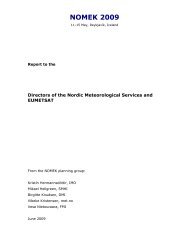International Symposium on Mitigative Measures against Snow ...
International Symposium on Mitigative Measures against Snow ...
International Symposium on Mitigative Measures against Snow ...
Create successful ePaper yourself
Turn your PDF publications into a flip-book with our unique Google optimized e-Paper software.
<str<strong>on</strong>g>Internati<strong>on</strong>al</str<strong>on</strong>g> <str<strong>on</strong>g>Symposium</str<strong>on</strong>g> <strong>on</strong> <strong>Mitigative</strong> <strong>Measures</strong> <strong>against</strong> <strong>Snow</strong> Avalanches<br />
Egilsstaðir, Iceland, March 11–14, 2008<br />
and released in October 2007. The advanced model provides simulati<strong>on</strong> tools for dense and<br />
for powder flow avalanches, depending <strong>on</strong> the respective settings. The previous Samos<br />
simulati<strong>on</strong> platform has been totally altered in order to provide improved results and an easier<br />
software handling. In regard of these enhanced technologies the appellati<strong>on</strong> Samos has been<br />
adapted by the affix AT for the Advanced Technology.<br />
2. OBJECTIVES<br />
The Samos model (release 1999) significantly overestimated the total avalanche runout<br />
distances. Especially the simulati<strong>on</strong> of the dense flow part resulted in n<strong>on</strong>satisfying outcomes<br />
mainly due to the fricti<strong>on</strong> model. The powder model, which is coupled with the dense flow<br />
part, overrated the runout particularly in the pressure z<strong>on</strong>e between 1−5 kPa. Therefore, the<br />
main emphasis in the development of SamosAT was the proper modelling of the dense flow<br />
part and the improvement of the runout behaviour for the powder part.<br />
3. METHODS<br />
Major changes have been made in the calculati<strong>on</strong> of the dense flow part, in the alterati<strong>on</strong> of<br />
the simulati<strong>on</strong> envir<strong>on</strong>ment of the powder part and finally in optimising the resuspensi<strong>on</strong><br />
layer, which is resp<strong>on</strong>sible for the transiti<strong>on</strong> of the dense snow into the powder layer.<br />
Extensive tests with various fricti<strong>on</strong> laws were necessary to find a suitable setup for properly<br />
modelling the dense flow avalanche.<br />
⎛<br />
⎞<br />
0<br />
2<br />
( b)<br />
R ( )<br />
0 tan ⎜<br />
s<br />
b ρ u<br />
τ = τ + δ ⋅ 1 ⎟<br />
⎜<br />
+ ⋅ +<br />
0 ⎟<br />
σ<br />
[1]<br />
2<br />
Rs<br />
+ Rs<br />
⎛ ⎞<br />
⎝<br />
⎠<br />
1 h<br />
⎜ ln + B⎟<br />
⎝ κ R ⎠<br />
The SamosAT fricti<strong>on</strong> law [1] in the actual setting provides suitable runout behaviour. The<br />
bed fricti<strong>on</strong> angle tanδ still plays the decisive role in the calculati<strong>on</strong> of the maximum<br />
0<br />
R<br />
avalanche runout. The term ( S , Rs) increases the bed fricti<strong>on</strong> angle at lower avalanche<br />
velocities in order to stop smaller avalanches more realistically and to prevent lateral<br />
0<br />
spreading of avalanches at very low flow heights (under 0,5 m depending <strong>on</strong> the setting).<br />
R S<br />
is an empirically determined c<strong>on</strong>stant to reduce the spreading of avalanches at very low<br />
velocities.<br />
Another step was the alterati<strong>on</strong> of the irregular Delauny triangulati<strong>on</strong> to a c<strong>on</strong>stant Eulerian<br />
grid. This improves the calculati<strong>on</strong> time, increases the stability and reduces random outliers.<br />
The flexible user interface provides extended possibilities in avalanche simulati<strong>on</strong>s especially<br />
in the data in- and output.<br />
The calculati<strong>on</strong> of the powder snow avalanche in the newly released model is performed <strong>on</strong><br />
an AVL-Swift V8 platform. The basic formulas have been adapted to the SamosAT model.<br />
Additi<strong>on</strong>ally, a real two phase calculati<strong>on</strong> model of ice particles and air has been integrated to<br />
obtain a more realistic simulati<strong>on</strong> of the aerosol. Besides the gain of mass particles, this<br />
method allows for a supplementary loss of snow particles al<strong>on</strong>g the avalanche path.<br />
Granig and Oberndorfer 49











